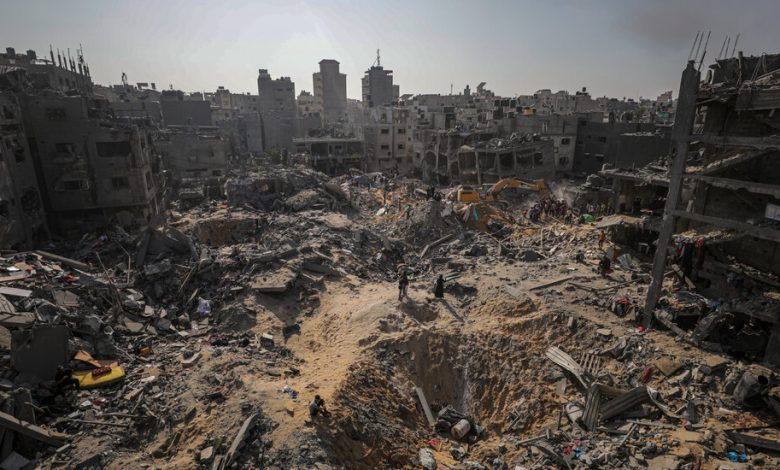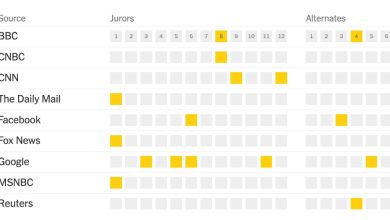Before a Truce, Israeli Officials Debated Whether a Pause Would Help Hamas

The Israeli decision on Wednesday to pause the invasion of Gaza to allow Hamas to release some hostages, a move now strongly supported by Prime Minister Benjamin Netanyahu, was the culmination of a weekslong dispute among Israel’s civilian and military leaders about whether such a deal would strengthen Hamas and endanger the remaining hostages.
One group of leaders led by Yoav Gallant, the Israeli defense minister, sought to delay the cease-fire and release of 50 hostages in exchange for 150 Palestinian prisoners held by Israel because of the fear it would slow the momentum of Israel’s invasion, allow Hamas to regroup and draw international attention away from the remaining 190 people held in captivity in Gaza.
Another group, which included David Barnea, the head of Mossad, Israel’s foreign intelligence agency, who led the negotiations for Israel, argued that the deal was better than none and that the invasion could continue after the brief cease-fire, according to four senior security officials who spoke anonymously because they were not authorized to speak to the news media.
The first group initially took the upper hand, persuading Mr. Netanyahu to delay a cabinet vote originally planned for Nov. 14, according to three of the officials. They hoped that more military pressure might give Israel more influence at the negotiating table, allowing more hostages to be freed.
But the second group eventually won out, leading Mr. Netanyahu to hold the vote early Wednesday, setting the stage for a four-day truce and prisoner exchange that could begin as soon as Thursday. A senior defense official from the first group said that its members had changed their minds because the terms that Israel was able to obtain in the signed deal were significantly better than those that existed a week ago.
Mr. Netanyahu’s office, the Israeli military and the Mossad all declined to comment.
The agreement came as Mr. Netanyahu faced competing pressures at home and abroad. The Biden administration has pushed him to agree to a hostage deal and a temporary truce amid rising international alarm about the heavy death toll and humanitarian crises caused by Israel’s 47-day bombardment and four-week invasion of Gaza.
At home, many Israelis are furious because Mr. Netanyahu’s government had failed to prevent the Hamas attack in southern Israel on Oct. 7 that started the war and led to the capture of roughly 240 hostages. Some Israelis are impatient for him to rout Hamas, even if it endangers the hostages; some want him to prioritize the hostages’ rescue, even if it slows the counterattack on Hamas; and others want a hostage deal only if it frees all of those Hamas captured last month, rather than just a few.
At least 12,700 people have been killed in Gaza, according to health officials in the Hamas-controlled enclave, since Israel began strikes in response to the Hamas raid that killed an estimated 1,200 people, according to Israeli officials.
While Israel initially drew widespread support in the aftermath of the Hamas attacks, its international partners — principally the United States — pushed Mr. Netanyahu to limit the civilian death toll and ease the devastation on Gaza’s remaining residents, most of whom fled their homes.
The tension within the Israeli leadership reflects a wider debate in Israeli society about the immediate priorities of the military as it responds to the Oct. 7 attacks. For many Israelis, the raison d’être of the state is to protect its citizens — and it failed last month, many say. How that protection should be restored has become a matter of public discussion.
Mr. Netanyahu and other Israeli leaders have repeatedly said that the main objectives of Israel’s invasion are to oust Hamas from Gaza and return all the hostages. To many Israelis, both objectives serve the same goal: the restoration of the state’s ability to protect its citizens.
But, in the short term, some say, the two objectives are in conflict with each other. By pushing relentlessly through the Gaza Strip in pursuit of Hamas, the Israeli military risks the death of hostages in the crossfire or in the Israeli bombardment. But by pausing the invasion and allowing the release of some hostages, the army may be giving Hamas time to regroup.
Under the deal, the Israeli air force would stop flying surveillance aircraft over southern Gaza and suspend flights over the north for six hours each day — potentially allowing Hamas to move its forces through the territory without being seen, analysts say.
“Who has the upper hand in the battle? Hamas,” said Fuad Khuffash, a Palestinian analyst close to Hamas. “Israel effectively agreed to Hamas’s conditions,” he added.
Some Israeli defense officials fear there is some truth to that assessment. But Israel’s hand was forced by a growing protest movement led by the hostages’ families that pushed Mr. Netanyahu to do more to save their relatives, according to Yagil Levy, a military expert at the Open University of Israel.
In recent days, thousands of demonstrators have marched about 40 miles from Tel Aviv to Jerusalem, calling on the government to help free the hostages. Mr. Netanyahu may have realized that “neglecting the issue of the hostages will contribute to a widening circle of antigovernment protests,” Dr. Levy said.
When Mr. Netanyahu came close last week to holding a cabinet vote on an earlier version of the cease-fire deal, Mr. Gallant and others successfully lobbied him to delay the vote to allow the Israeli army to press on with its invasion and capture Gaza’s largest hospital, Al-Shifa, among other targets.
Israel says the hospital conceals Hamas military infrastructure and has presented video of what it says is a tunnel leading under the hospital, as well as security camera footage of hostages being taken into the hospital. Hamas denies the claims.
Nearly a week after the army captured Al-Shifa, however, Mr. Gallant and his allies backed the cease-fire — giving it overwhelming support at the cabinet table — in part because they believed that the decision to capture a larger area of Gaza City had allowed Israel to gather more intelligence about the missing hostages, as well as weaken Hamas further. In Mr. Gallant’s view, that gave Israel a stronger position in the negotiations and enabled it to secure a better deal, according to a senior official familiar with Mr. Gallant’s perspective.
“What led to the result we hope we will reach in the near future is the determined, professional, precise and deadly action of the Israel Defense Forces,” Mr. Gallant said in the cabinet, according to a written transcript of his remarks provided by his ministry.
Other wavering ministers came around to the idea of a cease-fire because their government colleagues convinced them that they would support the resumption of fighting after a few days’ pause. Bezalel Smotrich, the far-right finance minister, initially said he would not support the deal, but changed his mind during the cabinet meeting, according to a recorded statement he provided to an Israeli journalist.
To win over Mr. Smotrich and others, the cabinet formally announced that “the fighting in the Gaza Strip will continue” after the cease-fire.
Yaakov Peri, a former head of the Shin Bet, the Israeli internal security service, said Israel had to accept the deal.
“Every hostage that Hamas wants to return, we can’t refuse,” Mr. Peri said, which gave Hamas a trump card in negotiations. Mr. Peri worries, however, that in this deal, “the chance for mishaps is high.” Even a minor incident could jeopardize the cease-fire, he added.
But despite the government’s plan to continue attacking Hamas after the cease-fire, Mr. Peri is not certain that will happen.
“When you stop a war, it’s difficult to revive the momentum,” he said.
Ronen Bergman and Adam Sella reported from Tel Aviv, and Patrick Kingsley and Aaron Boxerman from Jerusalem. Gabby Sobelman contributed reporting from Rehovot, Israel, and Johnatan Reiss from Tel Aviv.




